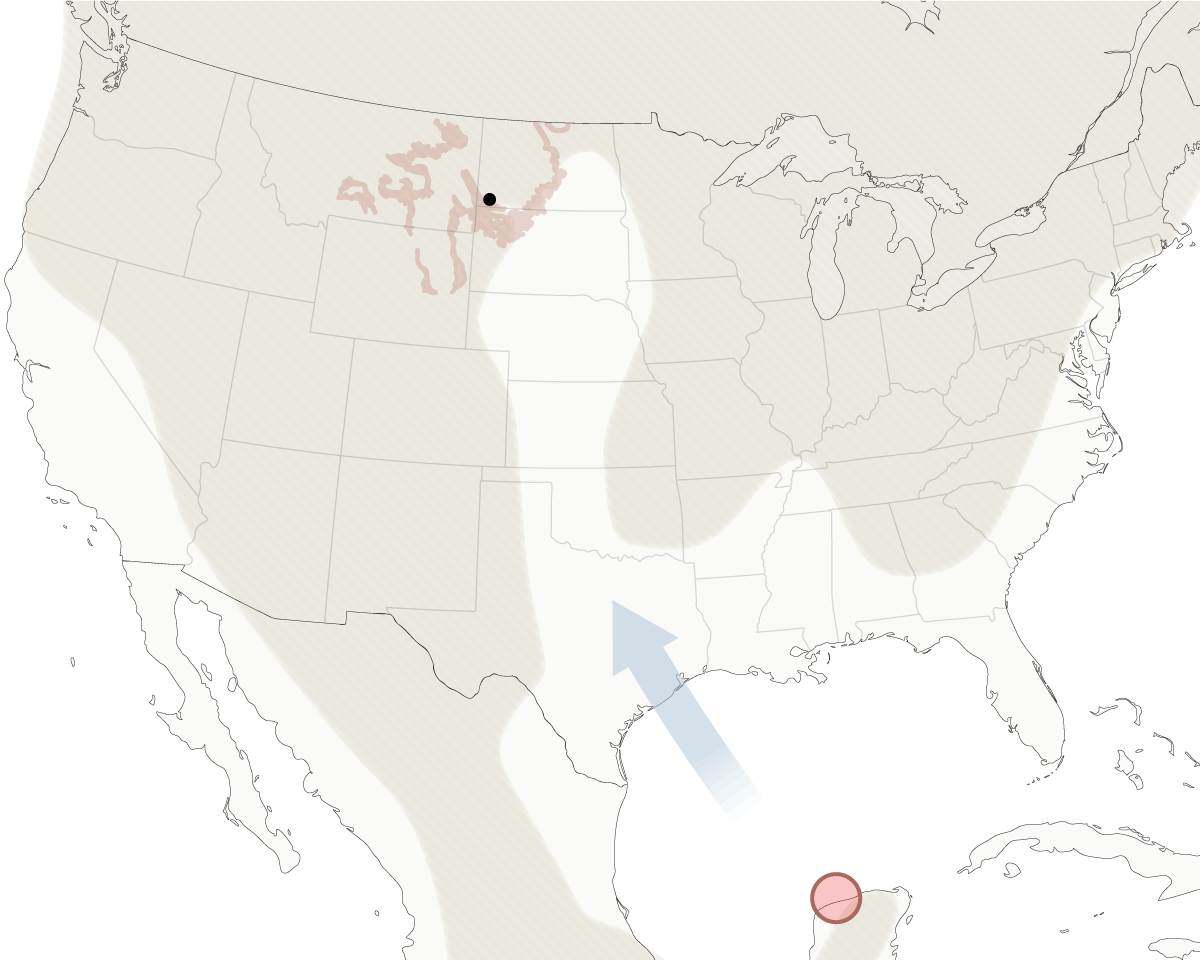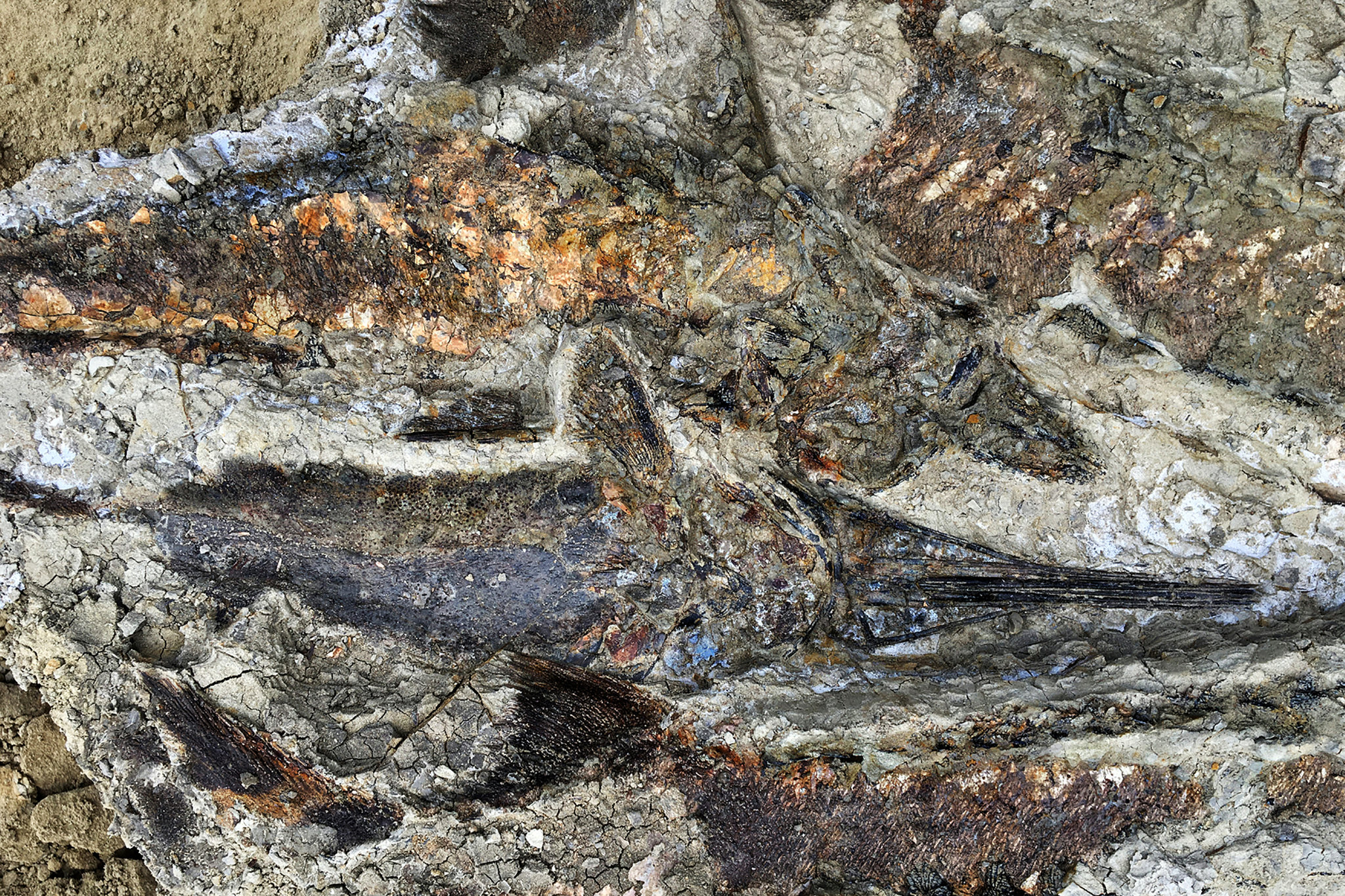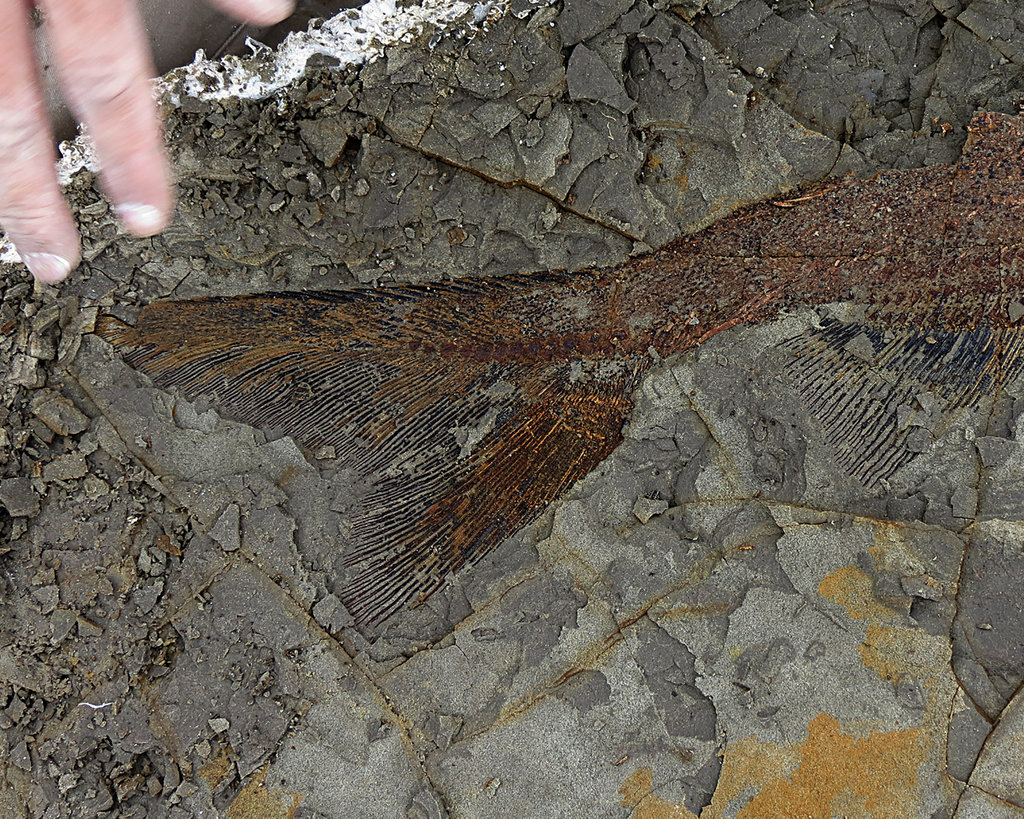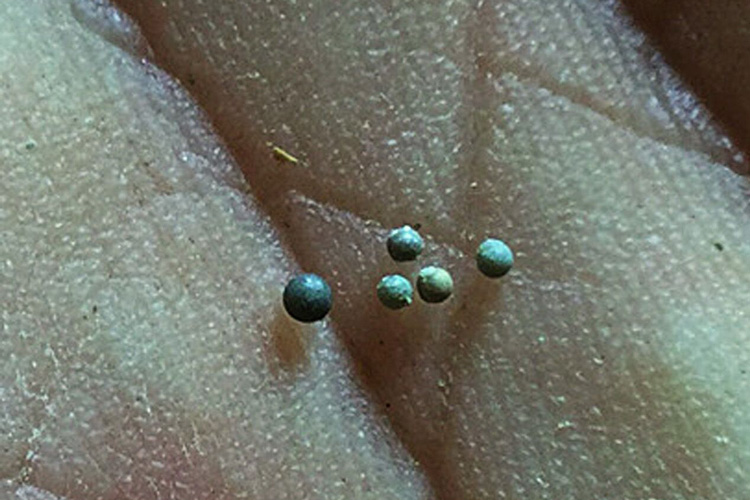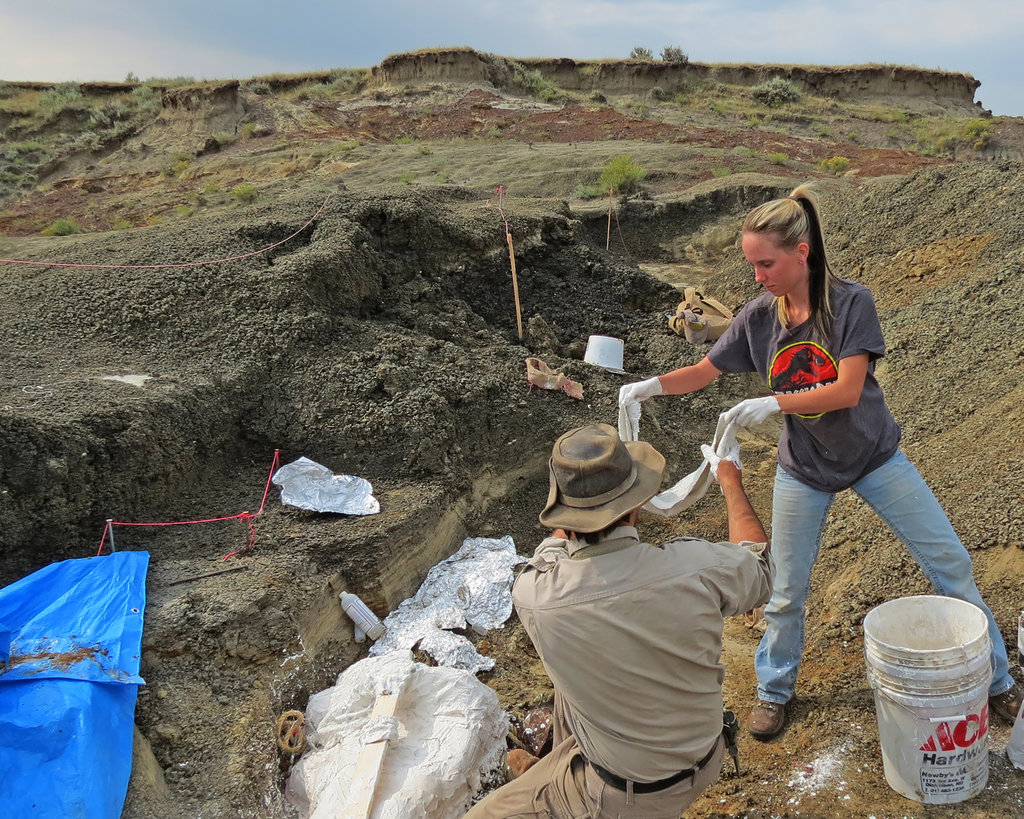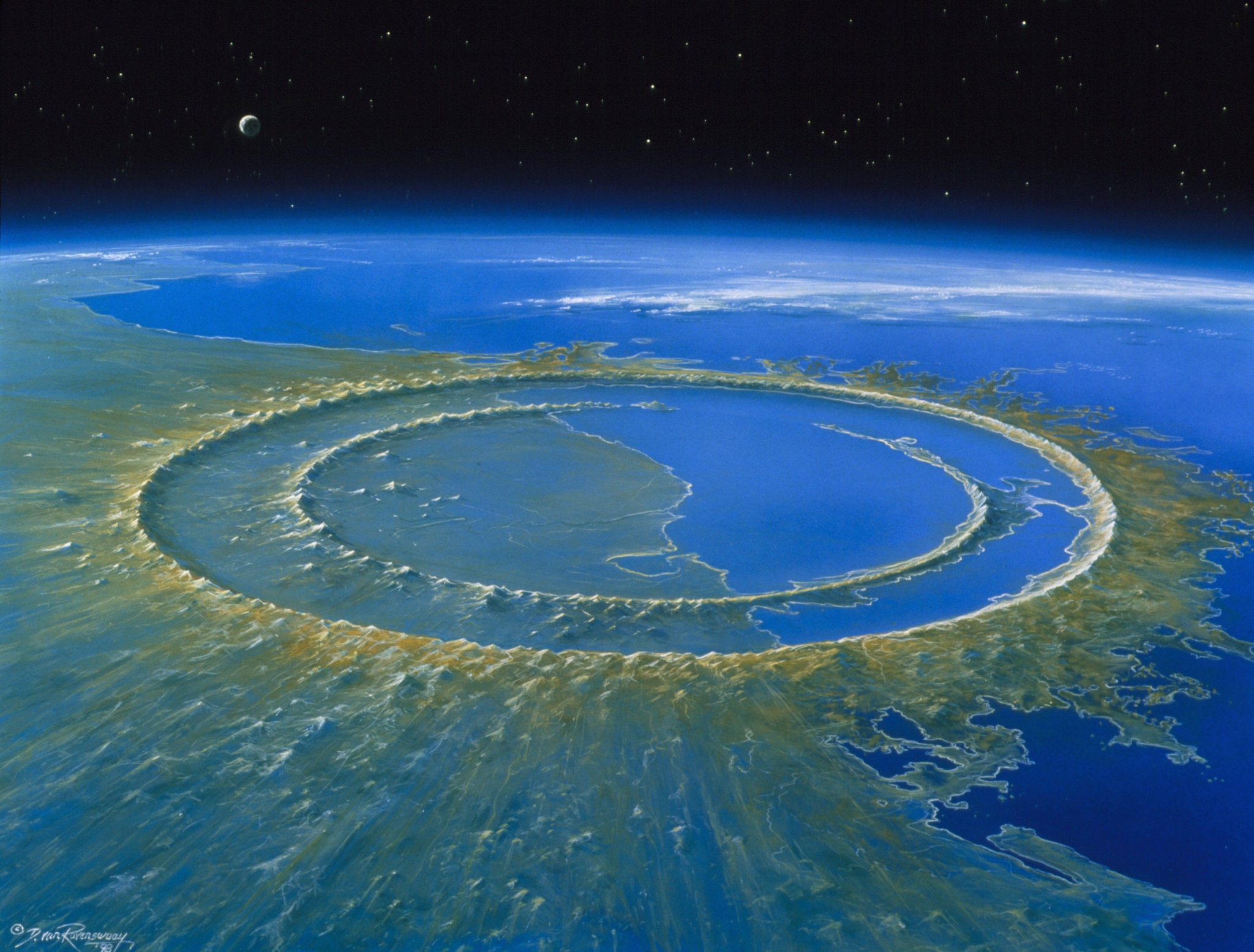Winston
Lorenzo von Matterhorn
- Joined
- Jan 31, 2009
- Messages
- 9,560
- Reaction score
- 1,748
Fantastic article on the impact effects and, even better, a long and fascinating description of the incredible fossil bed find, a bed made on the day perhaps even just an hour after the impact! The problem with the impact-caused extinction theory before had been that dinosaur fossils had never been found within 3 meters of the worldwide K-T boundary layer. This bed had plenty of them.
Annals of the Former World
The Day the Dinosaurs Died
A young paleontologist may have discovered a record of the most significant event in the history of life on Earth.
https://www.newyorker.com/magazine/2019/04/08/the-day-the-dinosaurs-died
If, on a certain evening about sixty-six million years ago, you had stood somewhere in North America and looked up at the sky, you would have soon made out what appeared to be a star. If you watched for an hour or two, the star would have seemed to grow in brightness, although it barely moved. That’s because it was not a star but an asteroid, and it was headed directly for Earth at about forty-five thousand miles an hour. Sixty hours later, the asteroid hit. The air in front was compressed and violently heated, and it blasted a hole through the atmosphere, generating a supersonic shock wave. The asteroid struck a shallow sea where the Yucatán peninsula is today. In that moment, the Cretaceous period ended and the Paleogene period began.
A few years ago, scientists at Los Alamos National Laboratory used what was then one of the world’s most powerful computers, the so-called Q Machine, to model the effects of the impact. The result was a slow-motion, second-by-second false-color video of the event. Within two minutes of slamming into Earth, the asteroid, which was at least six miles wide, had gouged a crater about eighteen miles deep and lofted twenty-five trillion metric tons of debris into the atmosphere. Picture the splash of a pebble falling into pond water, but on a planetary scale. When Earth’s crust rebounded, a peak higher than Mt. Everest briefly rose up. The energy released was more than that of a billion Hiroshima bombs, but the blast looked nothing like a nuclear explosion, with its signature mushroom cloud. Instead, the initial blowout formed a “rooster tail,” a gigantic jet of molten material, which exited the atmosphere, some of it fanning out over North America. Much of the material was several times hotter than the surface of the sun, and it set fire to everything within a thousand miles. In addition, an inverted cone of liquefied, superheated rock rose, spread outward as countless red-hot blobs of glass, called tektites, and blanketed the Western Hemisphere.
Some of the ejecta escaped Earth’s gravitational pull and went into irregular orbits around the sun. Over millions of years, bits of it found their way to other planets and moons in the solar system. Mars was eventually strewn with the debris—just as pieces of Mars, knocked aloft by ancient asteroid impacts, have been found on Earth. A 2013 study in the journal Astrobiology estimated that tens of thousands of pounds of impact rubble may have landed on Titan, a moon of Saturn, and on Europa and Callisto, which orbit Jupiter—three satellites that scientists believe may have promising habitats for life. Mathematical models indicate that at least some of this vagabond debris still harbored living microbes. The asteroid may have sown life throughout the solar system, even as it ravaged life on Earth.
The asteroid was vaporized on impact. Its substance, mingling with vaporized Earth rock, formed a fiery plume, which reached halfway to the moon before collapsing in a pillar of incandescent dust. Computer models suggest that the atmosphere within fifteen hundred miles of ground zero became red hot from the debris storm, triggering gigantic forest fires. As the Earth rotated, the airborne material converged at the opposite side of the planet, where it fell and set fire to the entire Indian subcontinent. Measurements of the layer of ash and soot that eventually coated the Earth indicate that fires consumed about seventy per cent of the world’s forests. Meanwhile, giant tsunamis resulting from the impact churned across the Gulf of Mexico, tearing up coastlines, sometimes peeling up hundreds of feet of rock, pushing debris inland and then sucking it back out into deep water, leaving jumbled deposits that oilmen sometimes encounter in the course of deep-sea drilling.
The damage had only begun.
[BIG snip]
The asteroid had likely struck in the fall, DePalma speculated. He had reached this conclusion by comparing the juvenile paddlefish and sturgeon he’d found with the species’ known growth rates and hatching seasons; he’d also found the seeds of conifers, figs, and certain flowers. “When we analyze the pollen and diatomaceous particles, that will narrow it down,” he said.
In the week that followed, fresh riches emerged: more feathers, leaves, seeds, and amber, along with several other fish, three to five feet long, and a dozen more craters with tektites. I have visited many paleontological sites, but I had never seen so many specimens found so quickly. Most digs are boring; days or weeks may pass with little found. DePalma seemed to make a noteworthy discovery about every half hour.
[snip]
Then DePalma came to a faint jug-shaped outline in the wall of the wash. He examined it closely. It started as a tunnel at the top of the KT layer, went down, and then widened into a round cavity, filled with soil of a different color, which stopped at the hard sandstone of the undisturbed bedrock layer below. It looked as though a small animal had dug through the mud to create a hideout. “Is that a burrow?” I asked.
DePalma scraped the area smooth with his bayonet, then sprayed it. “You’re darn right it is,” he said. “And this isn’t the burrow of a small dinosaur. It’s a mammal burrow.” (Burrows have characteristic shapes, depending on the species that inhabit them.) He peered at it, his eyes inches from the rock, probing it with the tip of the bayonet. “Gosh, I think it’s still in there!”
He planned to remove the entire burrow intact, in a block, and run it through a CT scanner back home, to see what it contained. “Any Cretaceous mammal burrow is incredibly rare,” he said. “But this one is impossible—it’s dug right through the KT boundary.” Perhaps, he said, the mammal survived the impact and the flood, burrowed into the mud to escape the freezing darkness, then died. “It may have been born in the Cretaceous and died in the Paleocene,” he said. “And to think—sixtysix million years later, a stinky monkey [ape - W] is digging it up, trying to figure out what happened.” He added, “If it’s a new species, I’ll name it after you.”
[snip]
Gradually, DePalma was piecing together a potential picture of the disaster. By the time the site flooded, the surrounding forest was already on fire, given the abundance of charcoal, charred wood, and amber he’d found at the site. The water arrived not as a curling wave but as a powerful, roiling rise, packed with disoriented fish and plant and animal debris, which, DePalma hypothesized, were laid down as the water slowed and receded.
[snip]
Annals of the Former World
The Day the Dinosaurs Died
A young paleontologist may have discovered a record of the most significant event in the history of life on Earth.
https://www.newyorker.com/magazine/2019/04/08/the-day-the-dinosaurs-died
If, on a certain evening about sixty-six million years ago, you had stood somewhere in North America and looked up at the sky, you would have soon made out what appeared to be a star. If you watched for an hour or two, the star would have seemed to grow in brightness, although it barely moved. That’s because it was not a star but an asteroid, and it was headed directly for Earth at about forty-five thousand miles an hour. Sixty hours later, the asteroid hit. The air in front was compressed and violently heated, and it blasted a hole through the atmosphere, generating a supersonic shock wave. The asteroid struck a shallow sea where the Yucatán peninsula is today. In that moment, the Cretaceous period ended and the Paleogene period began.
A few years ago, scientists at Los Alamos National Laboratory used what was then one of the world’s most powerful computers, the so-called Q Machine, to model the effects of the impact. The result was a slow-motion, second-by-second false-color video of the event. Within two minutes of slamming into Earth, the asteroid, which was at least six miles wide, had gouged a crater about eighteen miles deep and lofted twenty-five trillion metric tons of debris into the atmosphere. Picture the splash of a pebble falling into pond water, but on a planetary scale. When Earth’s crust rebounded, a peak higher than Mt. Everest briefly rose up. The energy released was more than that of a billion Hiroshima bombs, but the blast looked nothing like a nuclear explosion, with its signature mushroom cloud. Instead, the initial blowout formed a “rooster tail,” a gigantic jet of molten material, which exited the atmosphere, some of it fanning out over North America. Much of the material was several times hotter than the surface of the sun, and it set fire to everything within a thousand miles. In addition, an inverted cone of liquefied, superheated rock rose, spread outward as countless red-hot blobs of glass, called tektites, and blanketed the Western Hemisphere.
Some of the ejecta escaped Earth’s gravitational pull and went into irregular orbits around the sun. Over millions of years, bits of it found their way to other planets and moons in the solar system. Mars was eventually strewn with the debris—just as pieces of Mars, knocked aloft by ancient asteroid impacts, have been found on Earth. A 2013 study in the journal Astrobiology estimated that tens of thousands of pounds of impact rubble may have landed on Titan, a moon of Saturn, and on Europa and Callisto, which orbit Jupiter—three satellites that scientists believe may have promising habitats for life. Mathematical models indicate that at least some of this vagabond debris still harbored living microbes. The asteroid may have sown life throughout the solar system, even as it ravaged life on Earth.
The asteroid was vaporized on impact. Its substance, mingling with vaporized Earth rock, formed a fiery plume, which reached halfway to the moon before collapsing in a pillar of incandescent dust. Computer models suggest that the atmosphere within fifteen hundred miles of ground zero became red hot from the debris storm, triggering gigantic forest fires. As the Earth rotated, the airborne material converged at the opposite side of the planet, where it fell and set fire to the entire Indian subcontinent. Measurements of the layer of ash and soot that eventually coated the Earth indicate that fires consumed about seventy per cent of the world’s forests. Meanwhile, giant tsunamis resulting from the impact churned across the Gulf of Mexico, tearing up coastlines, sometimes peeling up hundreds of feet of rock, pushing debris inland and then sucking it back out into deep water, leaving jumbled deposits that oilmen sometimes encounter in the course of deep-sea drilling.
The damage had only begun.
[BIG snip]
The asteroid had likely struck in the fall, DePalma speculated. He had reached this conclusion by comparing the juvenile paddlefish and sturgeon he’d found with the species’ known growth rates and hatching seasons; he’d also found the seeds of conifers, figs, and certain flowers. “When we analyze the pollen and diatomaceous particles, that will narrow it down,” he said.
In the week that followed, fresh riches emerged: more feathers, leaves, seeds, and amber, along with several other fish, three to five feet long, and a dozen more craters with tektites. I have visited many paleontological sites, but I had never seen so many specimens found so quickly. Most digs are boring; days or weeks may pass with little found. DePalma seemed to make a noteworthy discovery about every half hour.
[snip]
Then DePalma came to a faint jug-shaped outline in the wall of the wash. He examined it closely. It started as a tunnel at the top of the KT layer, went down, and then widened into a round cavity, filled with soil of a different color, which stopped at the hard sandstone of the undisturbed bedrock layer below. It looked as though a small animal had dug through the mud to create a hideout. “Is that a burrow?” I asked.
DePalma scraped the area smooth with his bayonet, then sprayed it. “You’re darn right it is,” he said. “And this isn’t the burrow of a small dinosaur. It’s a mammal burrow.” (Burrows have characteristic shapes, depending on the species that inhabit them.) He peered at it, his eyes inches from the rock, probing it with the tip of the bayonet. “Gosh, I think it’s still in there!”
He planned to remove the entire burrow intact, in a block, and run it through a CT scanner back home, to see what it contained. “Any Cretaceous mammal burrow is incredibly rare,” he said. “But this one is impossible—it’s dug right through the KT boundary.” Perhaps, he said, the mammal survived the impact and the flood, burrowed into the mud to escape the freezing darkness, then died. “It may have been born in the Cretaceous and died in the Paleocene,” he said. “And to think—sixtysix million years later, a stinky monkey [ape - W] is digging it up, trying to figure out what happened.” He added, “If it’s a new species, I’ll name it after you.”
[snip]
Gradually, DePalma was piecing together a potential picture of the disaster. By the time the site flooded, the surrounding forest was already on fire, given the abundance of charcoal, charred wood, and amber he’d found at the site. The water arrived not as a curling wave but as a powerful, roiling rise, packed with disoriented fish and plant and animal debris, which, DePalma hypothesized, were laid down as the water slowed and receded.
[snip]




